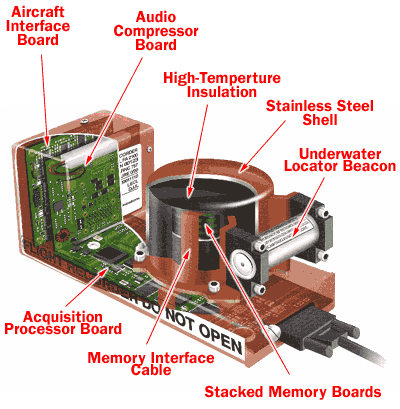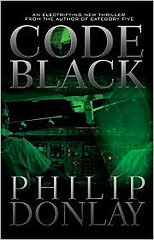COOL GADGET: THE BLACK BOX

One of the side effects of writing a novel is I get to do the research that helps me tell my story. One such learning experience involved creating a plane crash, at night, in the ocean, well out of radar contact. All communication with the aircraft is lost and the flight never arrives. Which poses the difficult question for all concerned: Where did it go, what happened, and why? Search and rescue elements are the first into the fray, floating debris is eventually located, and then accident investigators from the National Transportation Safety Board step into action. Their job is to start piecing together the evidence. In this case, a possible crime scene with hundreds of fatalities stretched out over several miles. Of course, the fact that the wreckage is 12,000 feet below the surface of the ocean makes the job even more difficult. The first order of business: Recover the black boxes.
Actual names of the devices:
Flight Data Recorder (FDR) and Cockpit Voice Recorder (CVR). They’re two separate units, and they’re not
black, they are in fact painted bright orange for higher visibility in the
recovery process.
Every airliner has some type of
black box installed, usually near the tail, if that gives you any hint where
scientists believe the least amount of damage occurs in a plane crash. Though I’m convinced they could install these
devices in the nose and they’d survive to tell their tale to investigators.
In testing the crash-worthiness
of the black boxes, they must be designed to survive the following:
a.) Being shot from an air cannon
to create an impact of 3,400Gs.
b.) A 500-pound weight, with a
quarter-inch steel pin attached, is dropped from ten feet to test for puncture
survivability.
c.) For five minutes, 5,000
pounds per square inch of crush force is applied to all axis points.
d.) For at least thirty minutes,
the box is placed in flames that reach 2000 degrees Fahrenheit. (Aluminum, the
prime material used in airliner construction, will melt at 1221 degrees
Fahrenheit.)
e.) The box must survive in salt
water for thirty days. These sturdy
gadgets will also survive an ocean plunge down to 20,000 feet, and automatically
begin to ping an acoustic signal for up to thirty days.
After all of these tests, the
data stored inside must still be retrievable.
These devices are made to survive because of what they contain. Stored inside on magnetic tape, or on a
memory chip, are all of the essential events leading up to a crash. The Cockpit Voice Recorder will record sounds
in the cockpit. The pilot’s conversations,
the radio transmissions, sound of other voices in the cockpit. All of the audio is preserved for the
investigators.
The Flight Data Recorder is
required to monitor at least eighty-eight parameters, such as heading, speed,
altitude, aircraft attitude in relation to level flight and so on. The end result is, once recovered, the accident
investigators can create a visual depiction of the aircraft’s final moments. It’s usually from that data, combined with
information from the CVR, that the root cause of the disaster is determined. It can be as obvious as a bomb, or the crew unwittingly
flying into the side of a mountain in weather, to the failure of a turbine
blade inside a jet engine. Using clues
from the black boxes, a Boeing 747 that crashed into the ocean off Long Island
was eventually salvaged and pieced back together in an empty hangar. Investigators then determined that defective
wiring had caused a fuel tank explosion.
At some point in the future,
there won’t be black boxes in airliners.
The flight and voice data will be streamed real-time via satellite and
stored until needed. Which means the
only black boxes recording data for accident investigators might be the one in
your car. But, until that day comes, hunting
black boxes on the ocean floor remains high adventure.











No comments:
Post a Comment